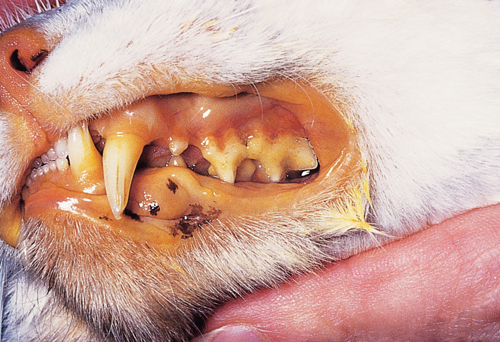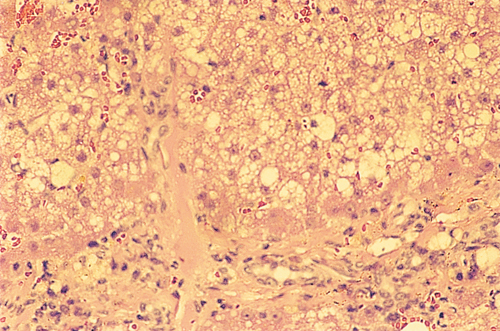Small Animal Abdominal and Metabolic Disorders Q&A 09
| This question was provided by Manson Publishing as part of the OVAL Project. See more Small Animal Abdominal and Metabolic Disorders Q&A. |
A four-year-old, neutered male, indoor domestic shorthair cat became inappetent soon after the owners moved in to a new home and obtained a puppy. The cat initially weighed 7.6 kg but within two weeks had lost 1.3 kg. On physical examination he was quiet, in fair body condition and markedly jaundiced. The rounded, caudal edge of the liver could be palpated beyond the costochondral junction. Pertinent laboratory findings included: PCV 0.42 l/l, ALP 522 u/l, ALT 168 u/l, GGT 2 u/l, total bilirubin 145 μmol/l and fasting bile acids 123 μmol/l. A liver biopsy was obtained.
| Question | Answer | Article | |
| What is your diagnosis? | The appearance of vacuolated hepatocytes in conjunction with the history of anorexia and weight loss support a diagnosis of hepatic lipidosis. The laboratory findings of a moderately elevated serum ALP activity in conjunction with a normal serum GGT activity can also be a clue, for this serum liver enzyme pattern is a characteristic finding in affected cats. An Oil-Red-O stain for lipids would confirm that the non-stained material within the hepatocytes is indeed lipid. |
Link to Article | |
| What are some of the predisposing factors of this condition for which this cat should be evaluated? | In approximately 50% of cases, hepatic lipidosis is secondary to another underlying disease process. The most common concurrent and/or causative diseases include diabetes mellitus, cholangiohepatitis, pancreatitis, renal disease, hyperthyroidism, neoplasia, cardiomyopathy and other systemic illnesses that result in anorexia for five days or longer. Idiopathic hepatic lipidosis (IHL) is a diagnosis of exclusion when no other underlying disease can be identified. Therefore, a thorough laboratory analysis including viral titres and endocrine function tests, as well as diagnostic imaging studies, are needed to rule out a primary disease process. Common denominating factors in animals that develop IHL seem to be a sedentary lifestyle, obesity and subsequent anorexia in association with an environmental stress such as changing home, or the introduction of a new, unfamiliar animal as in this cat’s history. |
Link to Article | |
| What are the important factors in the treatment of this condition? | Adequate protein-calorie nutrition is the cornerstone of therapy for the treatment of hepatic lipidosis. Although the underlying pathogenesis of hepatic lipidosis remains unknown, it appears that in times of excess ketogenesis, such as starvation, the feline liver lacks the ability to mobilize the excessively accumulating lipids, the hepatocytes become inundated with fat vacuoles, and a vicious cycle of anorexia and worsening liver function ensues. Since it is difficult to get these animals to eat an adequate amount of calories, and force feeding is rarely successful, the placement of a gastric feeding tube and the feeding of a moderate- to high-protein diet has improved the survival rate of cats affected with IHL significantly. The addition of essential amino acids such as carnitine, arginine and taurine have been advocated to assist in the mobilization of lipids from hepatocytes and the recovery of normal liver function. |
Link to Article | |

